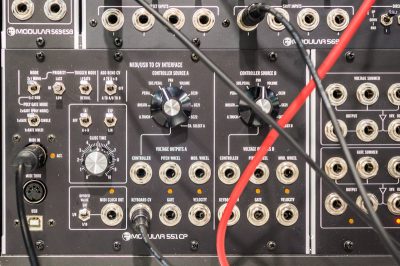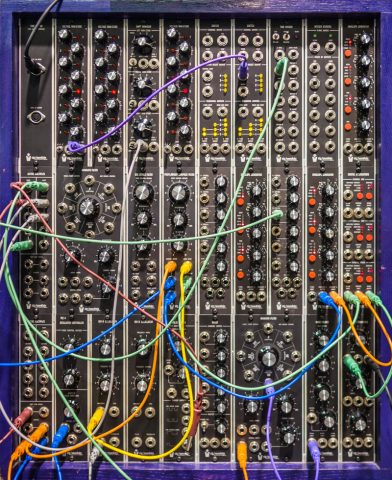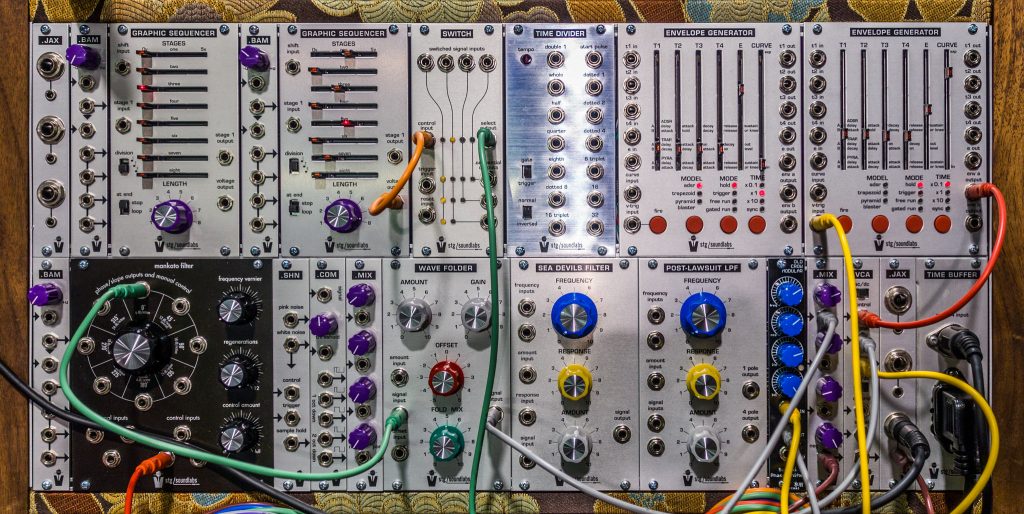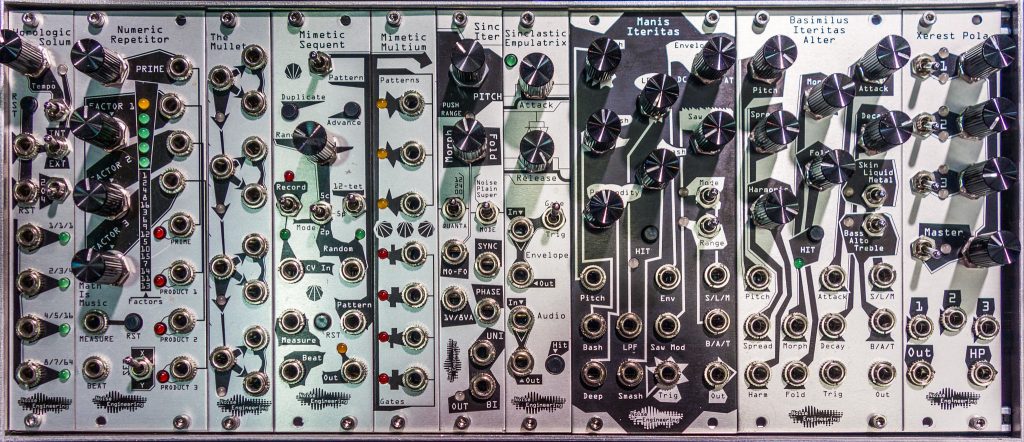The 5U or “Moog Unit” (MU) modular format does not get much representation at NAMM, with Moog, Moon Modular and STG Soundlabs being the usual stalwarts. Moog skipped NAMM this year, but an unexpected source – Noise Engineering – stepped into the breech with three new 5U modules – as well as a few new Eurorack ones too, of course. As usual, click on the images below to get a double-size version so you can see the front panel markings in more detail.
 Moon Modular
Moon Modular
Moon brought a number of new CP (console panel height, or 143 mm) format modules. They seemed most proud of their M 543 CP Four Channel Voltage Controlled Stereo Output Mixer (€502.52 + VAT), with voltage control over both level and panning. Each channel has a manual mute switch with status LED; the output section includes a separate headphone out that can be pre- or post-Master Volume. An A-440 tone generator is also built in for tuning.
 Additionally, they showed the new M 551 CP MIDI/USB to CV Interface (price not finalized), with a number of trigger priority options plus two selectable modulation control outputs. There were also CP format versions of their M 569 ESB and EGB sequencer expanders (€175.62 + VAT each); the full height versions were shown last year. One module not shown but in the planning stages is an M 504A transistor ladder filter with level compensation for the resonance.
Additionally, they showed the new M 551 CP MIDI/USB to CV Interface (price not finalized), with a number of trigger priority options plus two selectable modulation control outputs. There were also CP format versions of their M 569 ESB and EGB sequencer expanders (€175.62 + VAT each); the full height versions were shown last year. One module not shown but in the planning stages is an M 504A transistor ladder filter with level compensation for the resonance.
STG Soundlabs
STG is finally shipping their long-awaited Envelope Generator ($350 in Eurorack; $295 for base unit and $470 with sidecar in 5U/MU). Although this module takes pains to emulate the exact slopes of the original Moog 911 Envelope Generator in “exponential” mode, it is actually digital on the inside, operating at 12 bits with a 125 kHz update rate.

Two envelope outs? Yes, although there is just one set of knobs or generously long parameter sliders with three time scales (with the sustain level being to the right of the release rate, paying homage to the layout of the original Moog ADSR), there are two independent outputs. The Envelope Generator has three different operational modes – ADSR, Trapezoid, and “Pyramid Blaster” (a repeated attack at the end of the sustain stage), and two different outputs per mode. For example, while in ADSR mode, Envelope A Output is an AHDSR, while Envelope B is a DADSR. It may be easier to think of it as having six modes in all. It can also loop to act like an LFO.
An additional trick up its sleeve is that the STG Envelope Generator can sync to the STG Clock Bus: a form of DIN Sync that can be chained to together on the back of compatible STG and Five12 modules. In Sync mode, each stage’s conforms to a 32nd, 16th, 8th, quarter, half, and whole note, up to two bars.
I got one of the first Eurorack versions of these available immediately after the show, and look forward to putting it through its paces.
Noise Engineering
What would happen if you sent a Basimilus Iteritas Alter – already one of the most-loved aggro percussion modules available – “to hell and back”? That was the engineering brief for the new Manus Iteritas ($335). It is a little more analog in nature than the BIA – for example, a low pass filter replaces the BIA’s Morph function – and also capable of very overdriven sounds. I expect it to quickly become a standard in many racks. (By the way, Noise Engineering will also donate a portion of each MI sold to support SavePangolins.org – a scaly mammal that might be just tough withstand a Noise Engineering jam session.)
It’s been said that the secret to getting the most out of Noise Engineering modules like the BIA is to apply lots of modulation to their various control voltage inputs. In that vein, Noise Engineering also introduced a pair of modules squarely in the sequencing and modulation generation zone. I enjoyed the Mimetic Digitalis 4 row by 4 column “Cartesian” sequencer with 4 CVs and a trigger out ($255). You may have heard the term Cartesian sequencer used before by the Make Noise René. Mimetic Digitalis replaces the knobs of the René with a control voltage recorder and knobs on the front panel to enter your wigglings. It can also randomize the pattern with its Shred button. A good companion to it is the Clep Diaz Complex/Multimode CV Generator ($123): It’s a mere 4hp, offering step pattern, LFO, and random outputs. These are accompanied by the Bin Seq 8-step Switching Gate Sequencer ($123), Muta Jovis simple switchable quad mute ($85), and the long-promised Soleo Vero strobe-style tuner ($175).
And, as teased at the start, Noise Engineering is entering the 5U world with “Magnus” versions of their Basimilus Iteritas, Manus Iteritas, and Cursus Iteritas modules. They’re 2 Moog Units wide each, a scant 1.5” deep, and expected to list for $555 each.
I should also note that Buchla returned to the show floor, recently being bought by Foxtone Music – many have applauded this move as putting it in the hands of someone who truly cares about their history and synthesis in general, rather than just making a profit. They brought a Music Easel, manned by recently-installed resident historian Marc Doty, as well as a nice little 200e system from Noisebug (who also carry Moon Modular). I’m really looking forward to seeing what the company looks like by NAMM next year.



